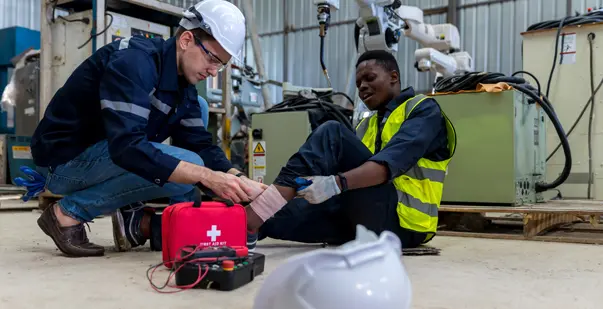The Importance of BLS for Police Officers: How it Can Save Lives?
13/11/2024

September 13, 2024
In high electrical energy environments like power plants, stations and construction sites, arc flash incidents are extremely common. According to the National Fire Protection Association, almost 5-10 arc flash incidents take place on a regular basis.
To simplify, arc flash is a phenomenon where current is sustained outside its normal conductive pathway. When it comes in contact with the air that has become ionized, it creates an explosive force with bright flash and intense heat. The intense heat from an arc flash causes severe burns, and at times knock workers off their feet.
Said to be three times hotter than the sun’s surface, this guide will break down the causes of arc flash, provide essential first aid tips, and outline practical strategies to prevent these incidents.
Arc flashes happen when electrical current leaves its intended path and travels through the air to another conductor or the ground. This can create a sudden, intense burst of energy that can cause serious injuries. Several factors can lead to an arc flash:
Preventing an arc flash emergency is crucial for ensuring safety in workplaces that involve electrical systems. You can reduce the risk of an arc flash incident by following specific safety measures and best practices. Here are some essential steps to prevent an arc flash emergency:
Providing immediate first aid after an arc flash incident minimizes injury and prevents further complications. Here’s what you should do if someone is involved in an arc flash:
Read More: Chemical Burns: First Aid Treatment and Prevention Tips
The long-term consequences for individuals affected by an arc flash can be severe and life-altering. Depending on the severity of the incident, these consequences may include:
Read More: How to Treat a Burn: Diagnosis & Treatment?
Assessing potential hazards in the workplace involves identifying risks and evaluating potential impact to ensure a safe environment. Here’s a straightforward approach to conducting a hazard assessment:
Examine all areas where work is performed, including equipment, electrical systems, and storage areas. Look for obvious hazards such as exposed wires, malfunctioning equipment, and unsafe work practices.
Review records of previous accidents or near-misses to identify recurring hazards or patterns. Check if there are frequent issues with equipment that could indicate underlying risks.
Talk to workers about their concerns and experiences with potential hazards in their daily tasks. Use their insights to identify risks that might not be immediately obvious.
List all potential hazards, including physical, chemical, biological, and ergonomic risks.
Determine the likelihood and severity of each hazard, considering both the probability of occurrence and the potential impact.
Utilize industry-specific safety checklists to ensure all potential hazards are covered. Refer to safety standards and guidelines (such as OSHA regulations) to ensure compliance and thoroughness.
Create and implement safety protocols to address identified hazards. Ensure appropriate personal protective equipment (PPE) is available and used correctly.
Reassess hazards regularly and whenever there are changes in the workplace, such as new equipment or processes. Adjust safety measures as needed based on new findings or changes in regulations.
Due to its numerous benefits in enhancing safety and preparedness, an arc flash training program is crucial for workers in environments with electrical systems. Here’s why such training is important:
OSHA (Occupational Safety and Health Administration) training and arc flash safety are closely related. OSHA sets standards and guidelines that directly impact how arc flash hazards are managed in the workplace. Here’s how they are correlated:
Compliance with OSHA Standards: OSHA requires employers to provide a safe working environment, which includes addressing electrical hazards such as arc flashes. OSHA’s standards, particularly those outlined in 29 CFR 1910 Subpart S, detail requirements for electrical safety, including arc flash hazard assessments and proper labeling.
Arc Flash Risk Assessment: OSHA mandates that employers conduct arc flash hazard assessments to identify and evaluate potential risks. This is a key component of OSHA training. It ensures that workers understand the need for risk assessments and the steps to take in case of an arc flash.
Training Requirements: OSHA’s regulations include specific training requirements for employees working with or near electrical systems. This training must cover the hazards associated with arc flashes, safe work practices, the proper use of personal protective equipment (PPE), and emergency response procedures.
Understanding arc flash incidents, along with its triggers and how to prevent them- is a crucial part of workplace safety and management. Arc flash incidents, if not properly taken care of can cause long term damages. Therefore it is important to consider common triggers like equipment failure, human error, and environmental factors. By implementing preventive measures, one can significantly reduce the chances of arc flash occurrence.
It is equally important to know how to respond effectively if an arc flash occurs. Immediate first aid, such as cooling burns, monitoring for shock, and seeking professional medical help, can make a significant difference in the outcome for affected individuals.
Last but not the least, prioritize regular training and stay updated with safety protocols to be prepared.